The "Final Solution of the Jewish Question" had a clear economic dimension for the Nazis from the outset. Before the Holocaust, it was planned to fully use the potential of the exterminated nation. But free slave labor was only one way to get richer ruthlessly in the Holocaust.
The process of the liquidation of the Jewish people, the concept of which was largely settled at the Wannsee Conference in early 1942, turned out to be surprisingly profitable for the Germans. The action "Reinhardt", which was a consequence of the meeting, led to the murder of almost two million Jews living in Polish lands. At the same time, the SS took over their property, the value of which could amount to as much as half a billion zlotys at that time, which amounts to between five and even eight billion zlotys.
The Nazis' appetite, however, grew with eating. Soon such "ordinary" profits were no longer enough for them. So more and more new sources of income were developed. How far were the Nazis willing to go in search of additional benefits?
Gold diggers
First of all, as the "Final Solution" progressed, the seizure of Jewish goods took more and more bestial forms. Gold teeth are in the spotlight. As one of the inmates of the Auschwitz camp, Michael Schonberger, recounts, “they did it with pliers. They tied a man like an animal and pulled out his teeth . The gold was smelt into bars and sent to the SS vaults. From there to Switzerland. ”
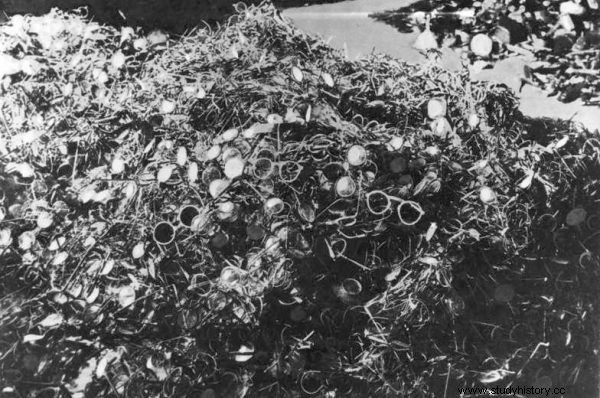
Robbing the victims of their valuables provided the Nazis with a huge inflow of gold. To get them, people had their gold teeth pulled out, wedding rings, gold-rimmed glasses, etc. were taken from them. The photo shows a stack of eyeglass frames at the Auschwitz Museum.
Ignacy Wieniarz, who worked at segregating valuables looted by the Nazis, has a similar memory from the camp. It lists the items that went into it:
We often got gold teeth with bone, rings and wedding rings - very often in the blood, sometimes with the skin. Silver - these were usually candlesticks, rather from synagogues and synagogues. There were also various kinds of chains [...].
There were eyeglasses, eyeglass frames and even gold binoculars. There was a lot of platinum and diamonds […]. I've been working with a giser sorting all these things. Because they were brought in haphazardly, a lot of precious, beautifully artistically made things got destroyed. Our job was to deliver more items for melting […].
Nothing can be wasted
The frighteningly efficiently organized machine of the Holocaust, however, induced the more resourceful to look for new sources of income. The way the people who hit her were treated as an object is evidenced by the gruesome excesses committed by the Nazi camp overseers. Ilse Koch, the "commando of Buchenwald", for example, wore handbags made of the skin of prisoners with tattoos.
A similar “trophy” was donated by Heinrich Himmler, who decorated his mountain home with… furniture made of human bones. To this day, it is also written about the use of human skin for lampshades, upholstery of furniture and book covers. These terrifying "mementos" were rather individual in nature, but it didn't take long for larger-scale projects to appear as well.
Human hair was certainly used in the Nazi industry. This is evidenced by a secret order addressed to the commanders of concentration camps on August 6, 1942. Oswald Pohl, chief administrator, reported that human hair was made into felt. He also stated that women's hair is used to make hair yarns for socks for submarine crews.
The affair gained momentum in early 1943. On January 4 and 11, the camp authorities were ordered to supply German companies with human hair. As a result, as Tony Paterson, a British journalist investigating the matter, writes:
The textiles produced by the German giant Schaeffler contained hair of at least 40,000. prisoners held and killed in the Nazi camp Schaeffler .
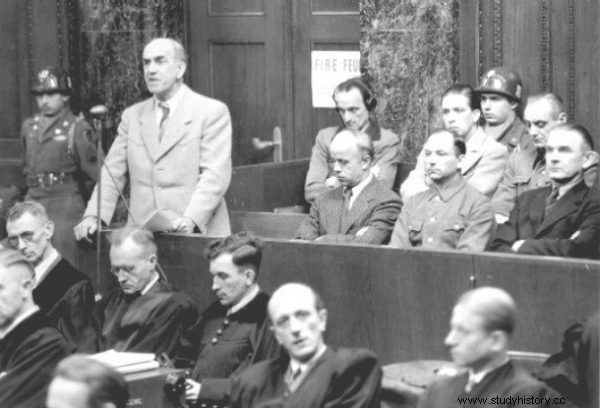
As confirmed by Oswald Pohl's report (he stands at the microphone during the Nuremberg trial), the hair of camp prisoners was used, for example, for the production of socks for the crews of German submarines.
Not only Schaeffler benefited from the monstrous deliveries. The Held company in Mieroszów in the Sudetes and a processing plant in Bremen also processed the hair of the camp victims.
A fairy-tale garden
Every Nazi officer delegated to governance in occupied countries gained virtually unlimited power over human life. Concentration camp overseers in particular quickly learned to use it. They made private farms, preying on the slave labor of prisoners.
Rudolf Höss, the commandant of the Auschwitz-Birkenau camp, turned out to be even more “ingenious”. He decided to use even the ashes of the murdered . This is evidenced by the words of Kazimiera Korzeniewska, a prisoner working in the Höss garden:
In the garden of the camp commandant, Rudolf Höss, we planted strawberries on the ashes from the burnt corpses of prisoners. The ashes were stored in the barn, from where we moved them to the garden.
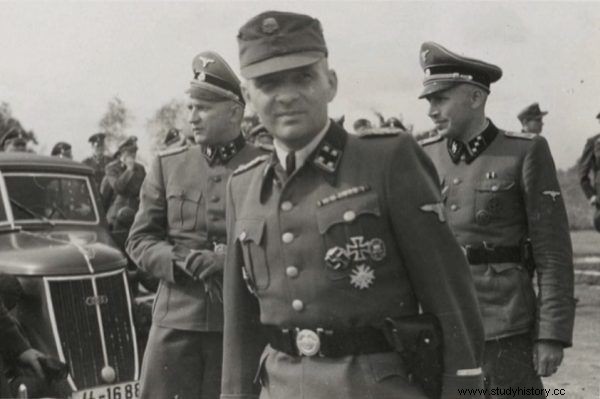
The commandant of Auschwitz, Rudolf Höss, ordered the ashes of the Holocaust victims to be used as fertilizer in his garden next to the camp.
There are many indications that the practice of the Höss family was not unique in Nazi circles. The Majdanek crew also came up with a similar idea of using the ashes of the victims to fertilize plants. But in this case, the home garden was not enough, but a profitable business was started.
According to Anna Żmijewska-Wiśniewska, one of the researchers of Nazi crimes, fertilizer was started in the Lublin camp. It was obtained from ground human bones. The resulting flour was sold in bags of 50 kilograms.
The family will always pay
Enterprising torturers quickly realized that not only farmers would be willing to pay for properly "presented" ashes of the victims. In Majdanek they were also offered to… families of prisoners.
Desperate relatives were consistently deceived at the same time. After paying a fee of ten marks, they received, as Żmijewska-Wiśniewska writes, "not authentic ashes, but a shovel of ashes from the first burnt corpse."
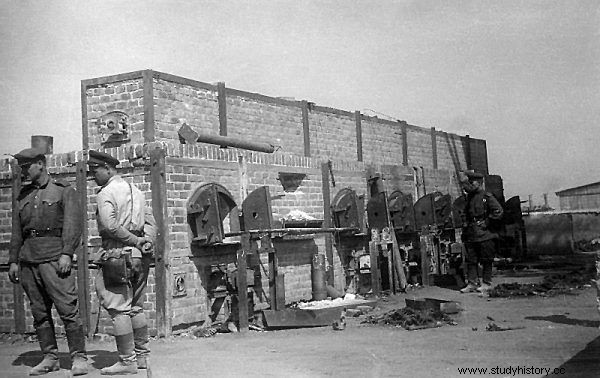
In Majdanek, the Nazis even went so far as to sell their relatives' ashes to their families. The photo shows the Red Army soldiers after the liberation of Majdanek.
It happened (as we wrote about HERE before) that ashes were sold even to families whose relatives had not died at all. It was another way to extort money from them. Unsuspecting relatives were notified of the death of a brother, son or husband in the camp, and offered to send his ashes - for a small fee, of course. The information was so credible that many people were fooled.
One of such stories was described by Millie Werber, a Polish Jew. The scam concerned her future husband, Jack. He found himself safe and sound ... after his father paid dearly to bring and bury his ashes. According to Millie, similar practices were common among the Nazis. "Throughout Poland, Jews were told that their sons, fathers and husbands were dead and that their ashes could be recovered for a fee," writes .
"Jewish" soap?
As the war progressed, the Nazis began to make even more far-reaching plans. They set out to develop a method of mass-producing soap from human fat. Rumors of soap labeled "RJP", which were read, among other things, as "Rein Juden Fett" (pure Jewish fat) were already common at that time.
Contrary to the horrific stories repeated during the Nuremberg trials, it was found that in 1945 such soap had not yet been produced on a mass scale. The infamous "RJP" or more specifically "RIP" was deciphered as "Reichsstelle für industrielle Fettversorgung" (literally:Industrial Fat Supply Center).
However, the whole story was not entirely without foundation. Much information was provided by the testimony of Zygmunt Mazur, an assistant in the Nazi laboratory at the Gdańsk Institute of Anatomy. He admitted that experiments related to obtaining soap from human fat on an industrial scale were carried out under the supervision of Professor Rudolf Spanner:
In February 1944, Professor Spanner gave me a prescription to make soap from human fat. […] The soap had an unpleasant odor […].
I boiled soap from the bodies of men and women. The cooking process itself took several days, from three to seven. In two production processes in which I was directly involved, produced more than 25 kilograms of soap . The amount of human fat needed for these two processes is 70 to 80 kilograms obtained from around 40 bodies. The finished soap went to Professor Spanner who kept it for himself.
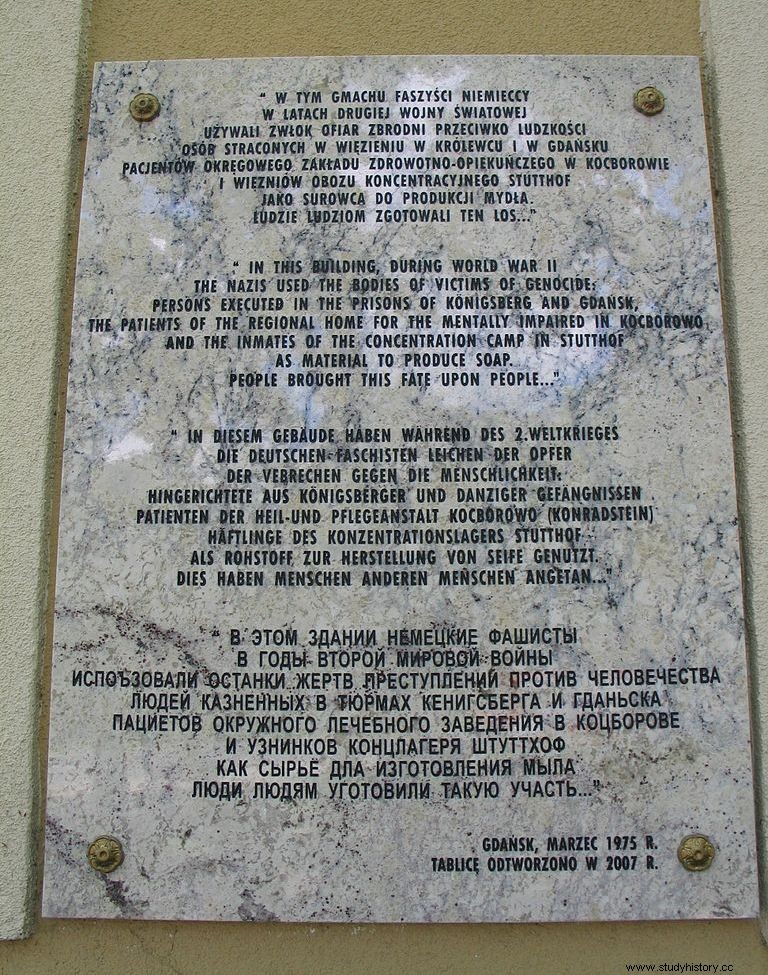
Board with information about Rudolf Spanner's experiments.
These revelations were finally confirmed in 2006 by an investigation conducted by the Institute of National Remembrance. It was found that human cadaver soap was actually produced in Gdańsk. If Mazur's testimony is to be believed, the production program had great prospects. The government of the Third Reich was keenly interested in the macabre research.
What is more, the testimony of the assistant professor Spanner shows that other work related to the use of the corpse was also carried out in the unit. Apparently, the process of collecting human skin has begun . What was it meant for? Masuria was unable to define it. We will probably never know, because this and other projects were soon ended with the collapse of Nazi Germany. And maybe it's better not to know.
Inspiration:
This article was inspired by Maciej Siembied's novel Place and Name , Capital Letter 2018.
